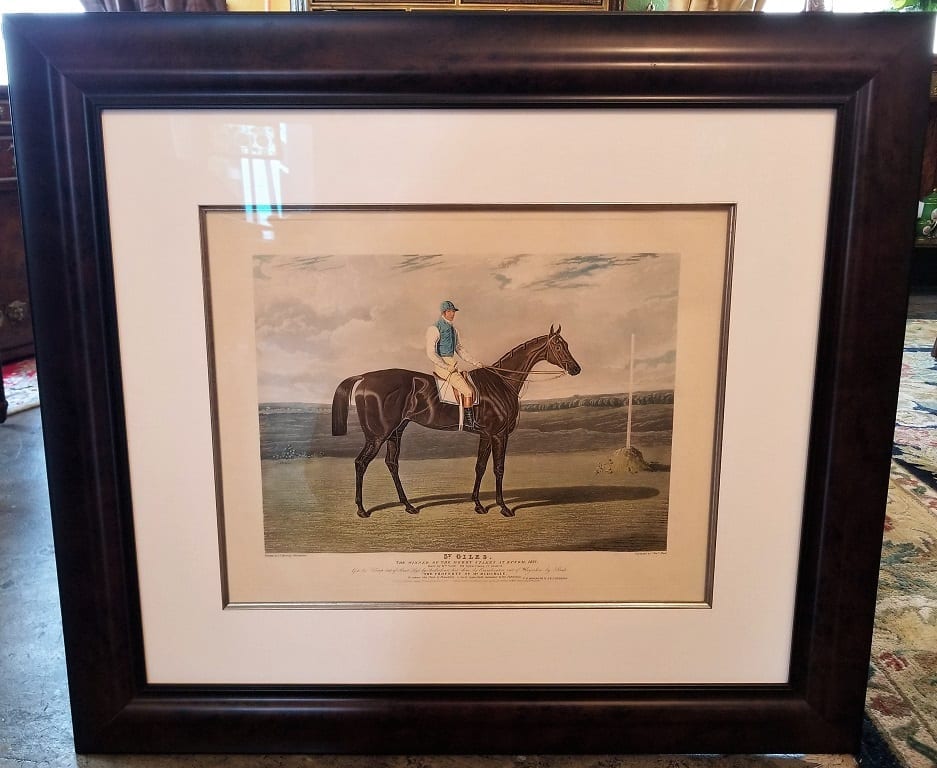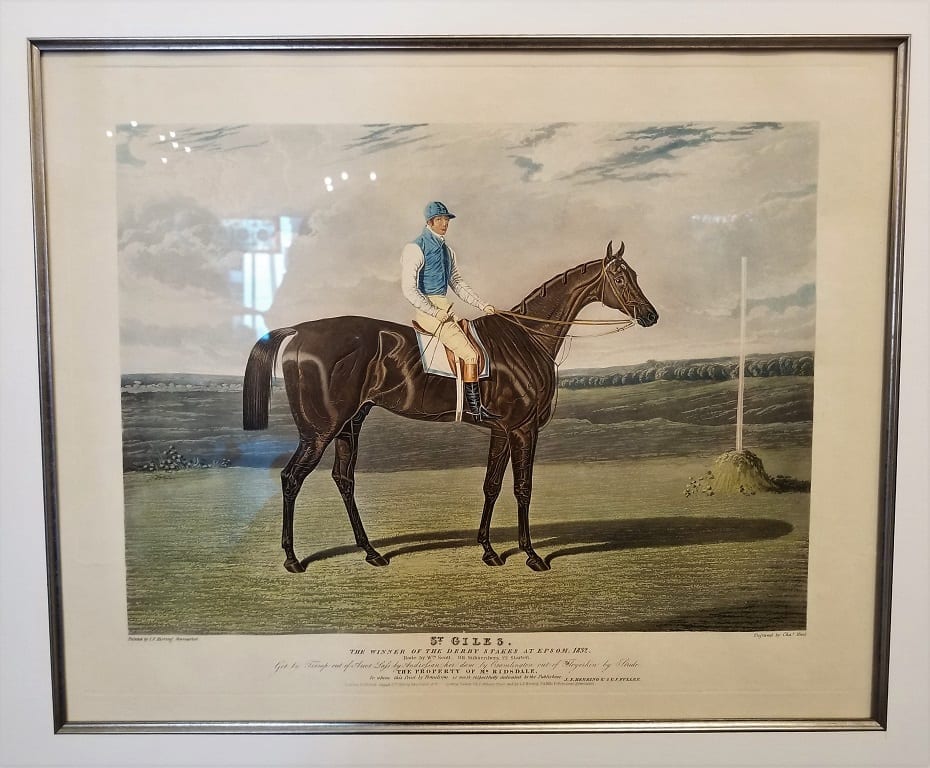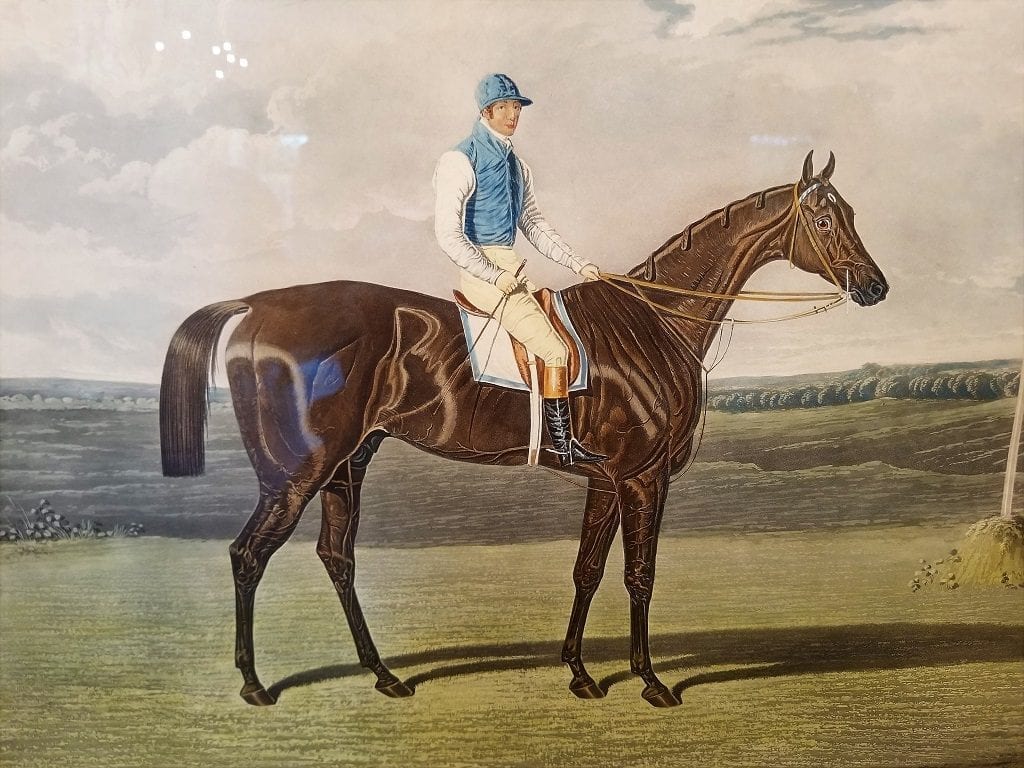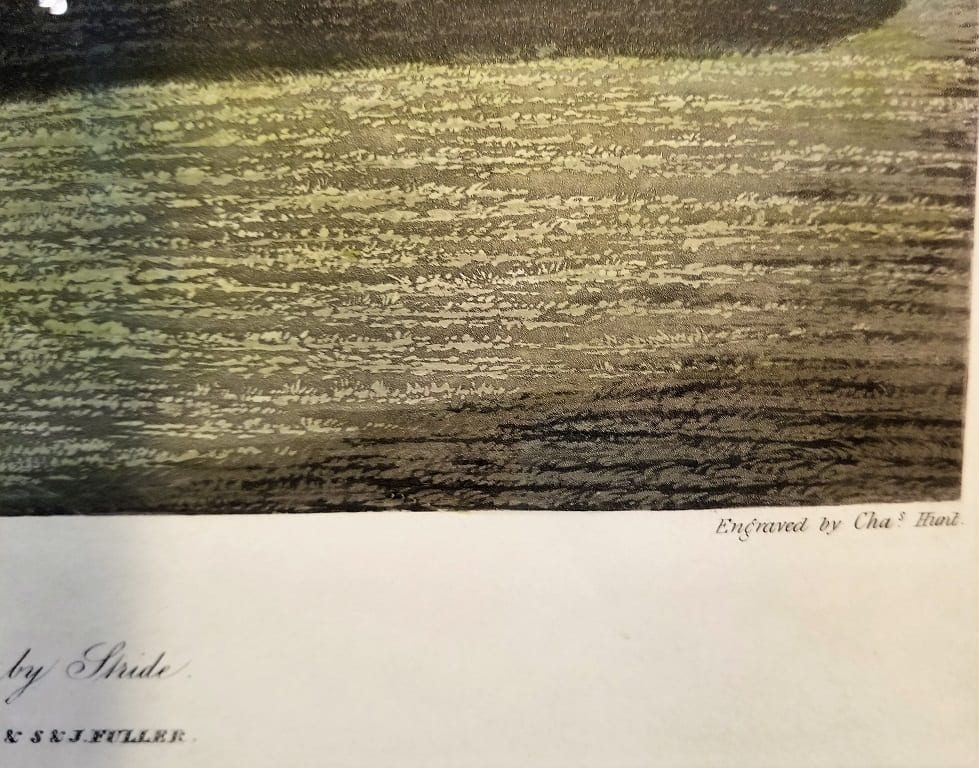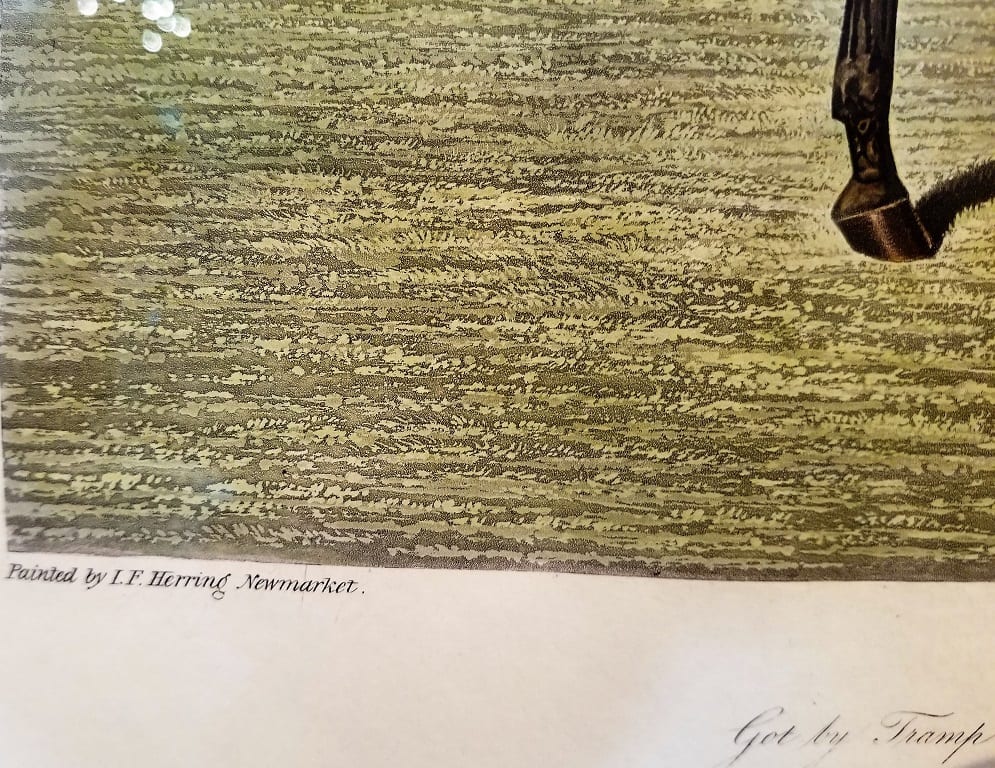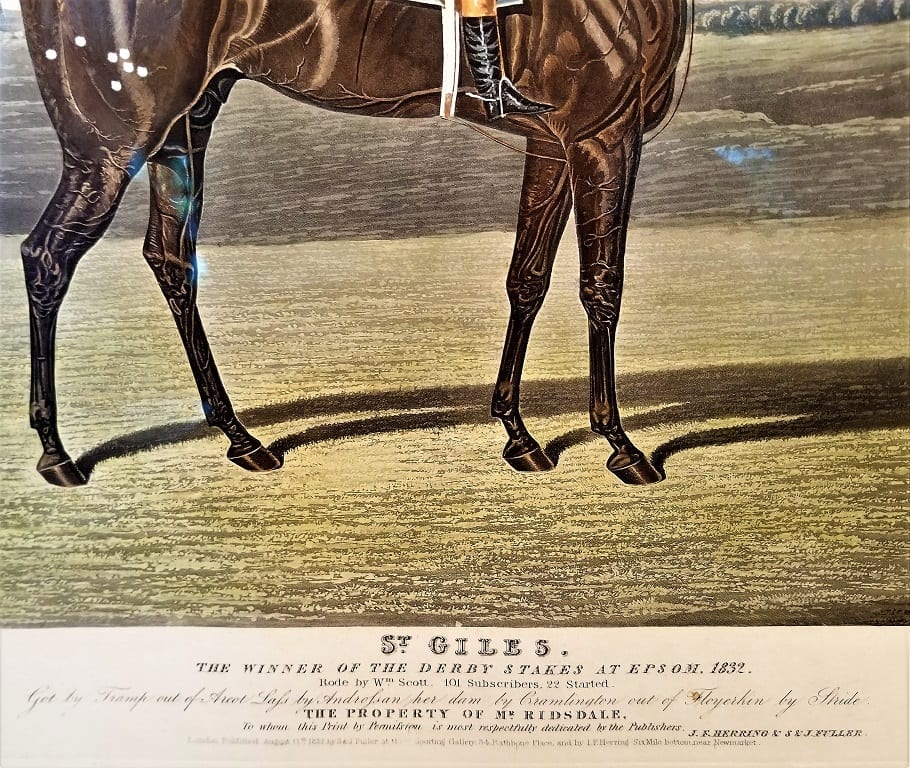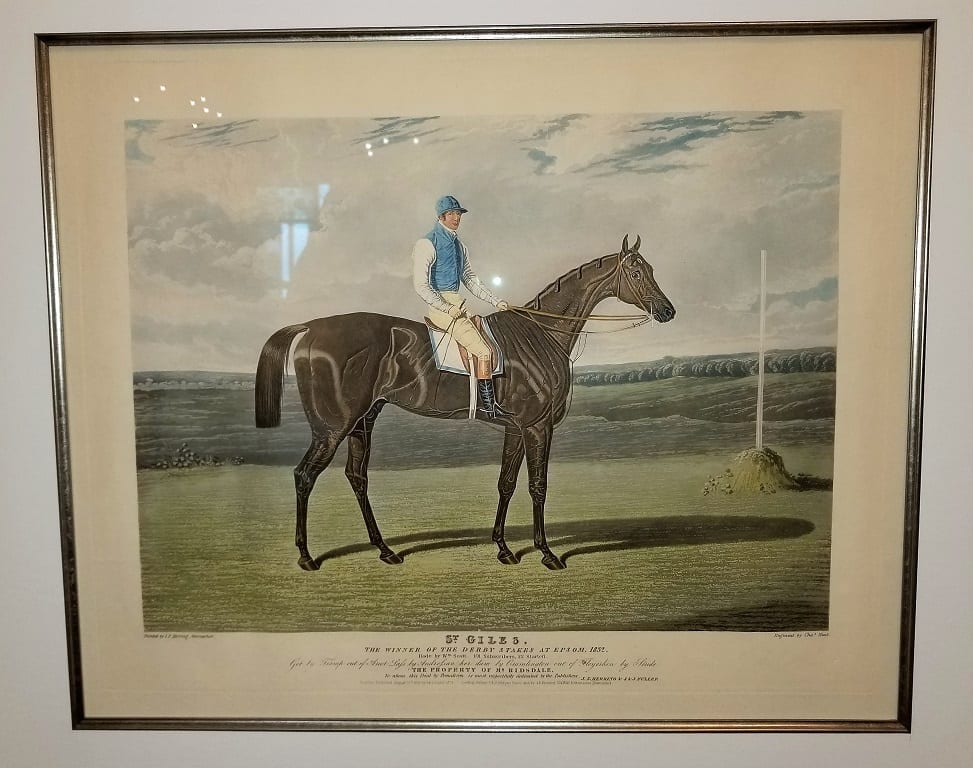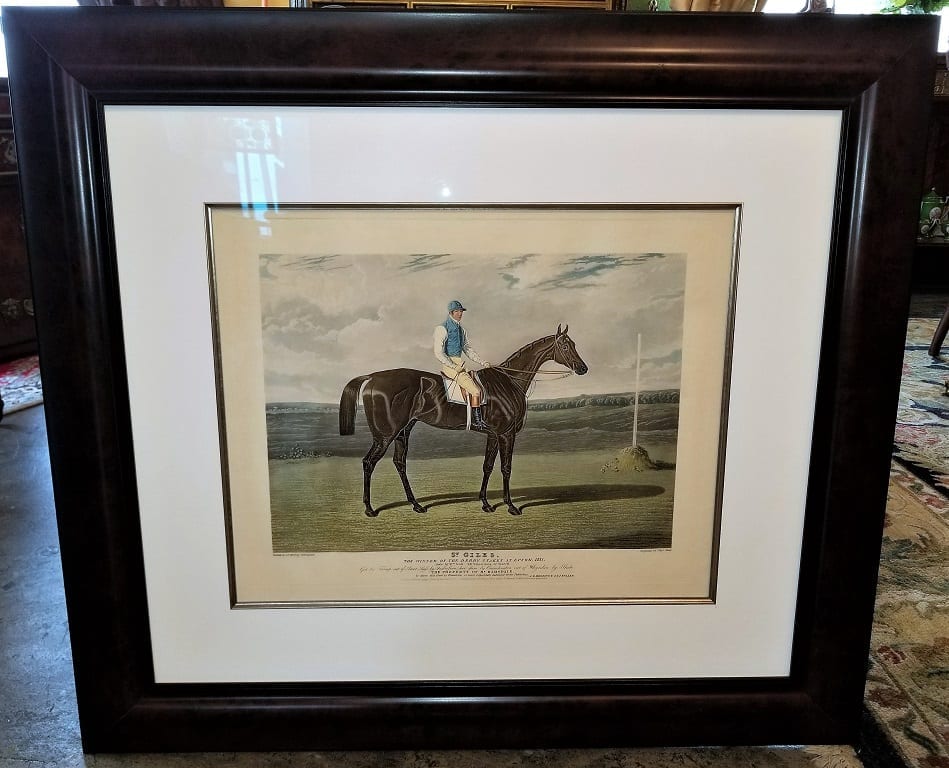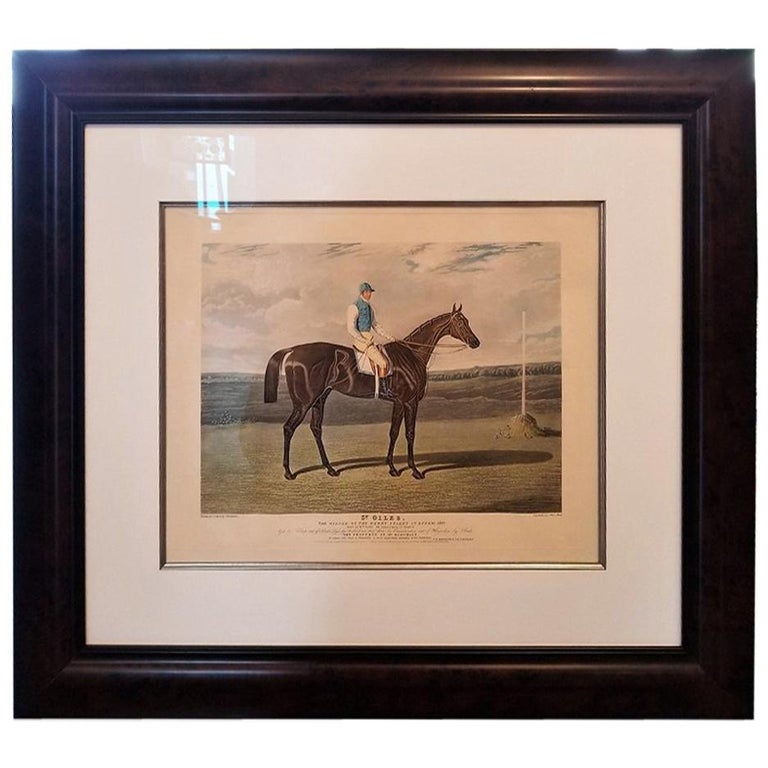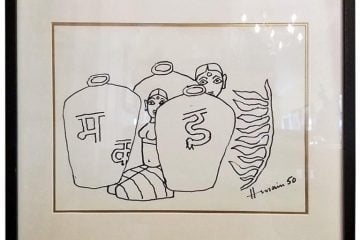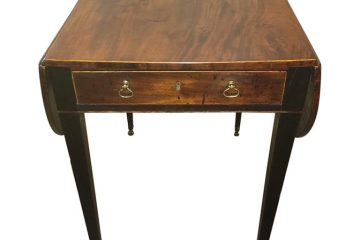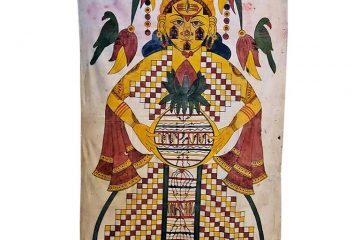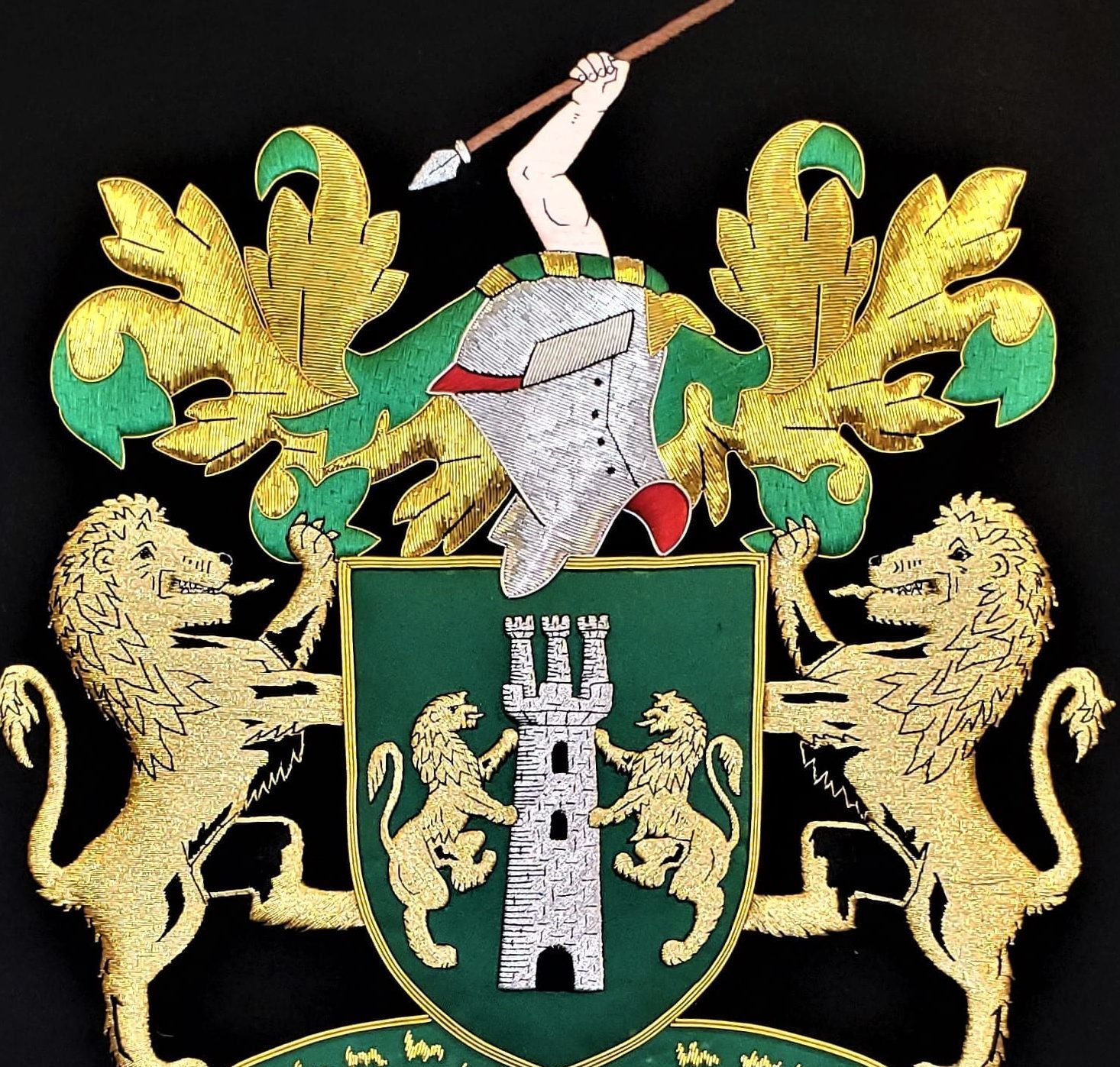PRESENTING a FABULOUS and VERY RARE, ORIGINAL Early-19th Century Engraving after a painting by John Frederick Herring Snr.
Engraved by Charles Hunt, circa 1832.
This original engraving is of “St. Giles” ….”The Winner of the Derby Stakes at Epsom, 1832” shown with his victorious rider/jockey, Bill Scott.

The engraving reports that of the 1832 Derby Stakes at Epsom…there were 101 Subscribers of which 22 started.
St. Giles’ breeding is recorded on the print as being “Got by Tramp out of Arcot Lass by Ardrossan her dam by Cramlington out of Floyerkin by Stride’.
The Owner of St. Giles is recorded as ” The Property of Mr. Risdale'”.
“To Whom this Print by permission is most respectfully dedicated by the Publishers…. J.F. Herring & S & J Fuller”.
“London published August 12th 1832 by S. & J. Fuller, at their Sporting Gallery, 34 Rathbone Place and J.F. Herring, Six Mile Bottom near Newmarket “.
“Painted by J.F. Herring, Newmarket”.
This Aquantint beautifully captures the Winning Horse and Jockey that were victorious in the 1832 running of the Derby Stakes at Epsom by John Frederick Herring, Sr.., one of Great Britain’s most renown sporting artists who did commissioned work for the Duchess of Kent and Queen Victoria. Herring’s Original aquatint, hand-colored prints are EXTREMELY POPULAR and HIGHLY SOUGHT AFTER. The engraving is presented under glass in its original oak frame with gilt fillets.
This ORIGINAL hand colored aquatint engraving of St. Giles is by the VERY FAMOUS and HIGHLY DESIRABLE and SOUGHT AFTER British Artist John Frederick Herring Senior.
The engraving is HUGELY IMPRESSIVE, EXCEEDINGLY RARE and in SUPERB CONDITION for its age !




John Frederick Herring Sr. (12 September 1795 – 23 September 1865), also known as John Frederick Herring I, was a painter, sign maker and coachman in Victorian England. He painted the 1848 “Pharoah’s Chariot Horses” (archaic spelling “Pharoah”). He amended his signature “SR” (senior) in 1836, with the growing fame of his teenage son (1 of 4) John Frederick Herring Jr.
Herring, born in London in 1795, was the son of a London merchant of Dutch parentage, who had been born overseas in America. The first eighteen years of Herring’s life were spent in London, where his greatest interests were drawing and horses. In the year 1814, at the age of 18, he moved to Doncaster in the north of England, arriving in time to witness the Duke of Hamilton’s “William” win the St. Leger Stakes horserace. By 1815, Herring had married Ann Harris; his sons John Frederick Herring Jr., Charles Herring, and Benjamin Herring were all to become artists, while his two daughters, Ann and Emma, both married painters. When she was barely of age in 1845 Ann married Harrison Weir.
In Doncaster, England, Herring was employed as a painter of inn signs and coach insignia on the sides of coaches, and his later contact with a firm owned by a Mr. Wood led to Herring’s subsequent employment as a night coach driver. Herring spent his spare time painting portraits of horses for inn parlors, and he became known as the “artist coachman” (at the time). Herring’s talent was recognized by wealthy customers, and he began painting hunters and racehorses for the gentry.
In 1830, John Frederick Herring, Senior left Doncaster for Newmarket, England, where he spent three years before moving to London, England. During this time, Herring might have received tuition from Abraham Cooper. In London, Herring experienced financial difficulties and was given financial assistance by W. T. Copeland, who commissioned many paintings, including some designs used for the Copeland Spode bone china. In 1840-1841, Herring visited Paris, painting several pictures, on the invitation of the Duc d’Orleans (the Duke of Orleans), son of the French King Louis-Phillipe.
In 1845, Herring was appointed Animal Painter to HRH the Duchess of Kent, followed by a subsequent commission from the ruling Queen Victoria, who remained a patron for the rest of his life.
In 1853, Herring moved to rural Kent in the southeast of England and stopped painting horse portraits. He spent the last 12 years of his life at Meopham Park near Tonbridge, where he lived as a country squire. He then broadened his subject matter by painting agricultural scenes and narrative pictures, as well as his better known sporting works of hunting, racing and shooting.
A highly successful and prolific artist, Herring ranks along with Sir Edwin Landseer as one of the more eminent animal painters of mid-nineteenth (19th) century Europe. The paintings of Herring were very popular, and many were engraved, including his 33 winners of the St. Leger and his 21 winners of the Derby. Herring exhibited at the Royal Academy from 1818–1865, at the British Institution from 1830–1865, and at the Society of British Artists in 1836-1852, where Herring became Vice-President in 1842.
Link: https://en.wikipedia.org/wiki/John_Frederick_Herring_Sr.




St. Giles (1829 – circa 1839) was a British Thoroughbred racehorse and sire. In a career that lasted from October 1831 to July 1835 he ran eleven times and won five races. After showing little form as a two-year-old, he made marked improvement to win his first three races of 1832, culminating with a highly-controversial success in The Derby. His only subsequent wins came in two minor races in 1835 and he was eventually sold and exported to stand as a stallion in the United States.
St. Giles was a dark chestnut horse bred by Mr Cattle, a farmer from Sheriff Hutton in Yorkshire. He was bought from his breeder by Robert Ridsdale, a professional gambler with a reputation for dishonesty and corruption. Ridsdale owned the colt in partnership with John Gully, a former champion prize-fighter and gambler who went on to become a Member of Parliament.
St. Giles was sired by Tramp, who won several important races in 1813 and 1814 and went on to become a very successful stallion, siring important winners including Dangerous(Epsom Derby) and Barefoot (St Leger). St. Giles’s dam, Arcot Lass was one of the few mares to produce two Derby winners, being also the dam of Bloomsbury
1831: two-year-old season
St. Giles was unnamed and ran as “Mr. Ridsdale’s ch. c. by Tramp out of Arcot Lass” when he made his debut in the Two-Year-Old Plate at Newmarket in October 1831. He started favourite at odds of 5/2 but finished unplaced behind the filly Miss Mary Anne. At the end of the month he returned to Newmarket for the Nursery Stakes, a handicap race over one mile in which he carried 104 pounds. Running for the first time as “St. Giles” he finished fourth of the six runners behind a colt named Gratis.
1832: three-year-old season
Spring
St. Giles showed much improved form in the spring of 1832. In April he defeated the year older filly Lioness by a head in a £100 match race over the Rowley Mile at Newmarket. He carried 112 pounds to the filly’s 130, giving him advantage of approximately eight pounds in modern, weight-for-age terms. Three days later he appeared in a handicap race in which he carried top weight of 115 pounds and won “cleverly” from an unnamed grey filly by Middleton. In these races was described as being a “two-year-old”, as racehorses at this time had their official “birthdays” on 1 May. From this point on St. Giles began to appear in the betting lists for the Derby. Shortly afterwards Gully purchased one of the Derby favourites Margrave for 2,500 guineas, and St. Giles became the subject of sustained support in the betting, leading to speculation that Gully and Ridsdale intended to manage the result of the race.
The Derby
At Epsom on 7 June, St. Giles, despite his modest public form, started the 3/1 favourite for the Derby in a field of twenty-two runners. In a series of private trial races, he had proved himself superior to Margrave and Ridsdale’s horse Trustee, and both his owners had backed him very heavily. After several false starts, the race got under way with Trustee setting a very strong pace and St. Giles, ridden by Bill Scott, settled in third. By half way, many of the runners were struggling but St. Giles was still going well and turned into the straight in second place. Just over two furlongs from the finish, Scott sent St. Giles past Trustee and into the lead. Although Perion moved strongly into second place, St. Giles was never seriously challenged and won comfortably by two lengths. Trustee held on for third and Gully’s Margrave finished fourth. Although the winner was trained at Newmarket, his owner and rider were Yorkshiremen and the race was seen as a victory for the North. Ridsdale, Gully and the bookmaker William Crockford were reported to have taken a combined total of almost £100,000 with Ridsdale alone winning £40,000 in addition to the £2,775 prize money.
Controversies
The victory of St. Giles was controversial in several ways. His stable companion, Margrave did not appear to have been given a hard race, and both Quarterly Review and the Sporting Review expressed the opinion that he had been held back from winning on Gully’s instructions. It was also widely believed that many of the runners had been “made safe”, meaning that their jockeys or trainers had been bribed to ensure they did not win. Immediately after the race, the owners of Perion lodged an official objection to the winner, on the grounds that the details of his dam’s pedigree had been incorrectly described on his race entry. They went so far as to have posters printed and displayed with the words “ST GILES NOT ENTITLED TO DERBY STAKES!”. Three senior members of the Jockey Club were called on to adjudicate and found in favour of Ridsdale. The issue, had in fact, been known for some time, and St Giles’ eligibility for the race had been in doubt since his wins at Newmarket. It seems that the Jockey Club took the view that the matter was a minor technicality, and that there had been no intent to deceive. As with other Derby winners of this period such as Mündig (1835), Bloomsbury (1839) and Little Wonder (1840), there appear to have been rumours that St. Giles was actually a four-year-old at the time of his Derby win.
After Epsom
On his only other start of the season, St. Giles started 5/2 second favourite in a highly anticipated race for the Goodwood Cup in late July. He looked to be traveling well but weakened in the closing stages and finished unplaced behind the 1830 Derby winner Priam. St. Giles had not been entered for the St Leger and a proposed match race at Doncaster against Lord Kelburne’s horse Retainer did not take place. His defeat at Goodwood therefore, proved to be his last race for two years.
The partnership between Ridsdale and Gully quickly broke down following a disagreement over money and their relationship ended in a physical altercation at a hunt in November. Gully was eventually prosecuted and obliged to pay damages of £500 for assaulting his former “friend”. Ridsdale, despite his massive gambling wins, became insolvent and was forced to sell all his property in 1836.
1834: five-year-old season
St. Giles, by now trained by John Barham Day at Danebury, finally reappeared in the Goodwood Cup of 1834 for which he started at odds of 12/1. He finished fourth of the ten runners in a strong field behind Glencoe. On his only other start of the year, St Giles ran in a race at Plymouth, which was to be decided in the old-fashioned way, with the winner being the first to win two heats. St. Giles sustained a bruised foot in the first heat and was withdrawn.
1835: six-year-old season
In either 1834 or early 1835, St. Giles was sold to Thomas Kirkby of York and moved to the stable of John Scott at Malton, North Yorkshire. On April 22, 1835, St. Giles recorded his first win for almost three years by beating seven opponents in the eleven furlong Craven Stakes at Catterick. A month later at York Racecourse he started at odds of 1/3 and claimed the one and three quarter mile Stand Purse by winning the first two heats.
In his final race, St. Giles ran in his third Goodwood Cup. On this occasion he started at 5/1 and was among the leaders throughout the race before finishing third to Rockingham and Glaucus.
Stud career
St. Giles was sold to James Jackson of Alabama in 1835 and exported to the United States in September of that year. In 1836, Jackson leased St. Giles to Colonel George Elliott of Tennessee who offered the stallion’s services at a fee of $60. He did not stand for the 1837 season because he was “out of condition.” While at Elliott’s farm for the season of 1837–1838, the normally docile St. Giles developed the habit of biting himself and tearing his own flesh after covering mares. To counteract this problem, sharp prongs were lashed to his sides to prevent him turning his head too far to the side. St. Giles made little impact as a sire and died before 1840.
Pedigree
| Sire Tramp(GB) 1810 | Dick Andrews 1797 | Joe Andrews | Eclipse |
|---|---|---|---|
| Amaranda | |||
| Highflyer mare (1790) | Highflyer | ||
| Cardinal Puff mare | |||
| Gohanna mare 1803 | Gohanna | Mercury | |
| Dundas’ Herod mare | |||
| Fraxinella | Trentham | ||
| Woodpecker mare | |||
| Dam Arcot Lass (GB) 1821 | Ardrossan 1809 | John Bull | Fortitude |
| Xantippe | |||
| Miss Whip | Volunteer | ||
| Wimbleton | |||
| Cramlington mare 1817 | Cramlington | Pipator | |
| Harriet | |||
| Floyerkin | Stride | ||
| Javelin mare (Family:9-c) |
Early 19C Aquatint Engraving of St. Giles by John Frederick Herring Snr
Additional Link: http://www.john-frederick-herring.org/
THIS IS A VERY RARE PRINT!
SIMILAR HERRING PRINTS HAVE BEEN SOLD BY CHRISTIES AND OTHER WELL KNOWN AUCTION HOUSES FOR THOUSANDS IN THE PAST!
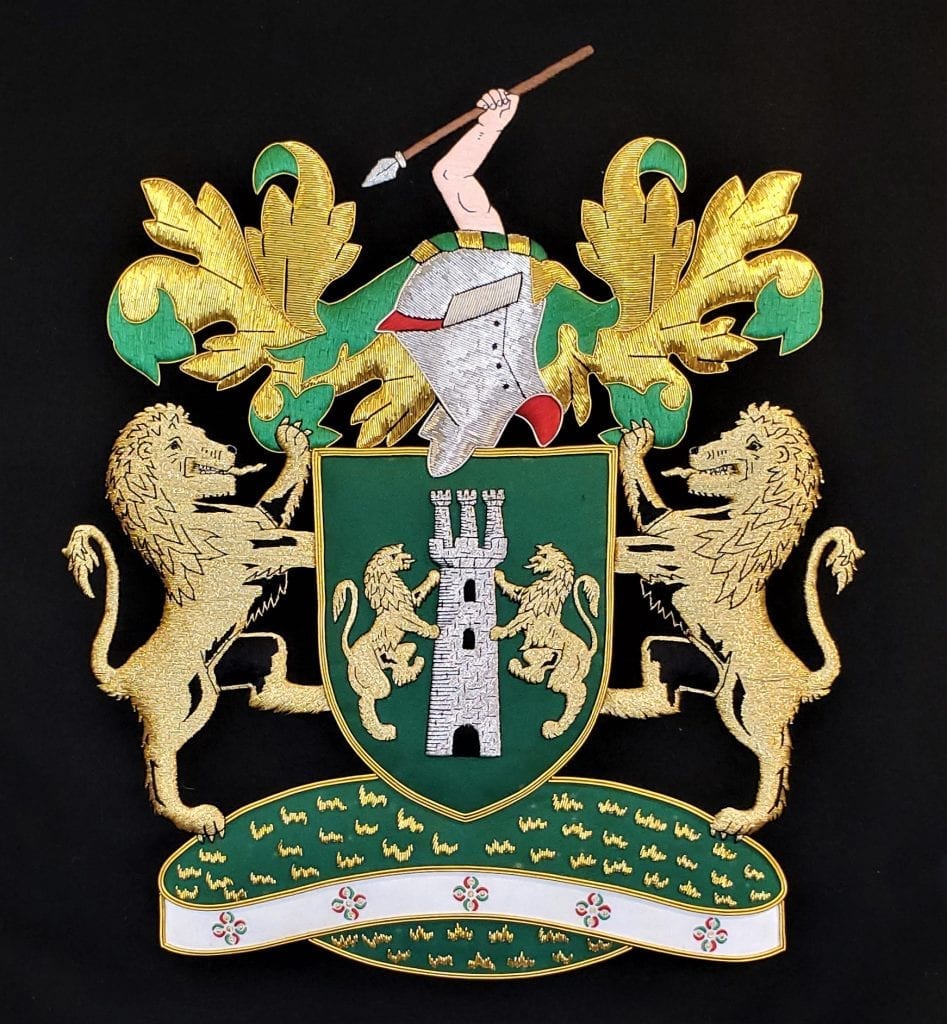

Early 19C Aquatint Engraving of St. Giles by John Frederick Herring Snr.
Condition: Consistent with it’s age and is superb for it’s age.
The engraving has been professionally framed in a dark walnut frame, with acid free matting and backing. Silver edging on the internal matte surround. The frame has anti-glare glass. The framing alone cost over $1,000.
We would not recommend any restoration to this print.
We are of the opinion that this is an ORIGINAL ENGRAVING. It was in the same ‘lot’ as an original ‘Proof’ engraving of ‘Foig-a-Ballagh’ by Hall (also in our Collection). It was originally acquired in Ireland in the 1960’s.
Provenance: Bought from a Collector in Kentucky.
Dimensions: It is 34.75 inches Wide, 31 inches Tall and 1.75 inches Deep (In Frame)
SALE PRICE NOW: $2,500
